Lamanai Archaeological Reserve Facts
Lamanai Archaeological Reserve Facts - Lamanai Mayan Ruins , "submerged crocodile" is a Mesoamerican archaeological site, and was once a major city of the Maya civilization, located in the north of Belize, in Orange Walk District. The site's name is pre-Columbian, recorded by early Spanish missionaries, and documented over a millennium earlier in Maya inscriptions as Lam'an'ain. Lamanai is renowned for its exceptionally long occupation spanning three millennia, beginning in the Early Preclassic Maya period and continuing through the Spanish and British Colonial periods, into the 20th century. Unlike most Classic-period sites in the southern Maya lowlands, Lamanai was not abandoned at the end of the 10th century AD.
History of Lamanai
Lamanai was occupied as early as the 16th century BC. The site became a prominent centre in the Pre-Classic Period, from the 4th century BC through the 1st century CE. In 625 CE, "Stele 9" was erected there in the Yucatec language of the Maya. Lamanai continued to be occupied up to the 17th century AD. During the Spanish conquest of Yucatán Spanish friars established two Roman Catholic churches here, but a Maya revolt drove the Spanish out. The site was subsequently incorporated by the British in British Honduras, passing with that colony's independence to Belize.
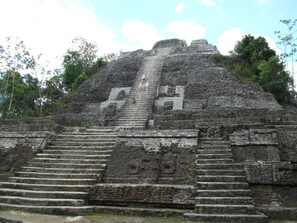
Lamanai Site description
The vast majority of the site remained unexcavated until the mid-1970s. Archaeological work has concentrated on the investigation and restoration of the larger structures, most notably the Mask Temple, Jaguar Temple, and High Temple. The summit of this latter structure affords a view across the surrounding jungle to a nearby lagoon, part of New River.
A significant portion of the Temple of the Jaguar Masks remains under grassy earth or is covered in dense jungle growth. Fully excavated, it would be significantly taller than the High Temple. In the jaguar temple there is a legend that you can find an ancient spear called the heart of the jaguar, even though the temple got his name from the jaguar masks on each side.
The Maya ruins of Lamanai once belonged to a sizable Mayan city in the Orange Walk District of Belize. "Lamanai" comes from the Maya term for "submerged crocodile", a nod to the toothy reptiles who live along the banks of the New River. Lamanai Belize jungle brims with exotic birds and hydrophilic iguanas. There is evidence on Mayan life that dates from about 1500 B.C. through Postclassic (A.D. 950-1544) and Spanish colonial times (A.D. 1544-1700)
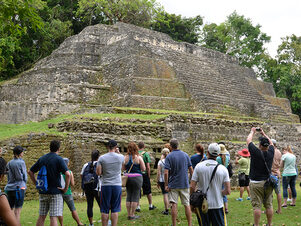
Copper artifacts and their significance at Lamanai
Among the many important aspects of Postclassic and early Spanish colonial period Maya life at Lamanai is shown by the presence of significant numbers of copper artifacts. Copper indicates broader trade relations in the southern Maya lowlands, and as a reflection of technological change, the history of metal artifact use at Lamanai is an invaluable element in the reconstruction of Postclassic and early historical dynamics. The archaeological contexts of copper objects recovered at Lamanai beginning, with the appearance of metal at the site by around A.D. 1150.
The archaeological contexts in which copper objects have been recovered at the ancient Maya site of Lamanai in northern Belize have great significance in that these objects served great purpose for the residents of the community during Postclassic time that dates from A.D. 950-1544. Nearly all of the copper objects found at Lamanai are distinctly Mesoamerican in form and design and based on metallurgical analyses it appears that manufacturing technologies were distinctly Mesoamerican as well. The presence of production materials and mis-cast pieces along with the results of chemical compositional and micro structural analysis support the idea that the Mayans at Lamanai were engaged in the on-site production of copper objects by late pre- Columbian times.(cite scott article). Objects are classified and examined in the contexts, forms, styles, uses, and sources of copper objects dating from the Buk ceramic phase, which coincides with the Early Postclassic period (A.D. 950-1200).
There were copper objects recovered at Lamanai beginning, with the appearance of metal at the site by around A.D. 1150. The term "copper" is used to describe the metal found at the site; however, all of the copper artifacts found at Lamanai were alloyed with other metals such as tin or arsenic and could technically be considered bronze (Hosler 1994: 210-213).
The number and variety of copper objects recovered at Lamanai indicate that, as a new commodity with remarkably unique aural and visual properties, metal artifacts played an important role for at least some members of Postclassic and later contact period society. Masson notes that "metal was probably the most highvalued luxury good in this region of the Postclassic Maya world" (2003: 279). The inclusion of copper bells, elaborate rings, and button like ornaments in Early and Middle Postclassic elite burials shows that at least some residents of the site displayed such items in certain social and ritual settings. Copper bells worn during performances acted as auditory reminders of the high social standing of those who displayed them, and the lustrous copper finger rings and elaborate clothing ornaments served as visual indicators of elevated status
Trade
Trade was an essential component of Mesoamerican life in the Postclassic period and the Maya were active participants in a vast macro regional trade network. The movement of commodities as well as information and ideas into interior areas of the peninsula was facilitated by canoe travel along the coast and the extensive river systems in Belize. The importation of finished copper objects into the Maya area during Postclassic times was made possible by a vibrant, well-established exchange network that included Lamanai and a number of smaller Postclassic sites in northern Belize
Lamanai's key location on the New River Lagoon provided the site's inhabitants with access to a variety of Mesoamerican trade goods throughout of the site's 3500-year occupation. Copper objects such as bells, rings, and tweezers not only had great economic value but were also highly charged symbolic objects whose sounds and colors made them particularly important for use in ritual performances and as ornaments reflecting social status. More copper artifacts have been recovered at Lamanai than at any other site in the ancient Maya world. To date, a total of 187 copper artifacts have been excavated, including bells, rings, tweezers, various clothing ornaments, pins, axes, chisels, needles, and fish hooks.
Lamanai Jaguar Temple, Lamanai Mask Temple and Lamanai High Temple
At the site are structures that date from AD 625: The Jaguar Temple, named for its boxy jaguar decoration; the Mask Temple, adorned by a 13-foot stone mask of an ancient Maya king; and the High Temple, offering visitors a panoramic view from its summit.
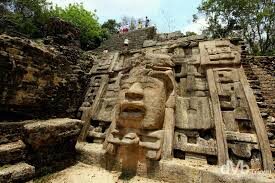
The most interesting features at the structure are two masks that decorate the west facade of the temple. The masks are on two levels on the south side of a central stairway, on the lower level the masks more than 15 feet high. It represents a rather humanized face and is bordered by decorative elements. The headdress of the mask represents a crocodile. These masks are construed of stone armature covered with thick stucco into which the details are carved. The masks date to the late fifth to the early sixth century. At Lamanai, ceremonialism was strongly developed, providing evidence of ruling authority with tight control over the populace.
At the large temple there was a single ball court, where an offering had been placed under its giant central marker. A lidded bowl contained 100g of crystalline hematite, 19 g of cinnabar in a miniature vessel, and other objects such as jade, shell, and pearl, all atop of a pool of mercury. Previously mercury had been found at Copan, Quirigua, and at Kaminaljuyo and lake Amtitlan, but not in such large quantity. This large amount of mercury found at the site of Lamanai had been probably collected for ritual use. Ceramics were also found at the site and gradually adopted new styles. Unfortunately, by the end of the Classic period, the norm here for burial custom was to smash vessels prior to interment.
Lamanai Mayan Ruins Tour
Visiting Lamanai Archaeological Reserve is like going on three adventures in one day. Your fun day begins at the port of Belize City, where you are transported in a comfortable air-conditioned van. We drive you through Belize City on to the Northern Highway where you get to see the countryside and learn about the culture of Northern Belize. Your guide will be pointing out important monuments and landmarks as we head towards the New River. You will arrive in Orange Walk Town also known locally as “Sugar City”, where you will board our boat that begins the wild life adventure up the New River. Your guides will highlight the wild life of the New River such as the spider monkeys, crocodiles, the variety of birds, and the flora and fauna along the New River banks.
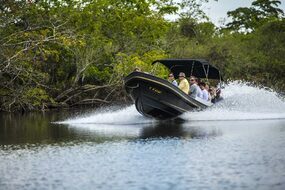
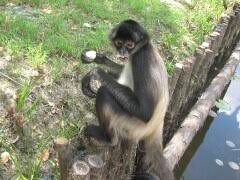
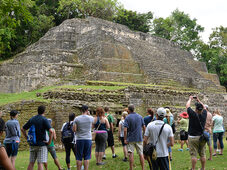
On arrival at Lamanai situated off the New River Lagoon, you will be treated to a delicious Belizean buffet-style lunch of Rice & Beans, potato salad, coleslaw and fry plantain. Be sure to try out our spicy “hot” tomato habanero sauce. You’ll have a choice of an ice-cold soda or water, and the meal includes tropical fruits for dessert. After lunch, we make a start hiking to the temples of Lamanai and while on the path we’ll be looking out for the Howler monkeys and the colorful Toucans that are predominant in the area. As we arrive at the Lamanai Mayan ruins you will get to look at the Mask Temple, the High Temple, the Ball Court, the residential area and the Jaguar Temple. Your guide will give you detailed information on the historic significance of each area, and you will get the opportunity to climb up the High Temple via the original stairway built by the Mayas, and get a spectacular panoramic view of the lagoon and the surrounding jungle.
For cruise ship customers, we will pick you up at the port entry and get you back with lots of time to spare.
USD $145.00 per person
4 persons: USD$110.00 per person with lunch
Group of 6+: USD $100.00 per person with lunch
Guests staying in Ambergris Caye, San Pedro, and Caye Caulker need to board the 6:00 am water taxi to Belize City. We will be there with a sign that reads your name.
Please note that the prices of our tours may vary depending on the number of persons booking. This is because we offer strictly private tours.
For reservations kindly complete the contact form below.
PLEASE DON'T INCLUDE CREDIT CARD INFORMATION IN THE CONTACT FORM BELOW.
